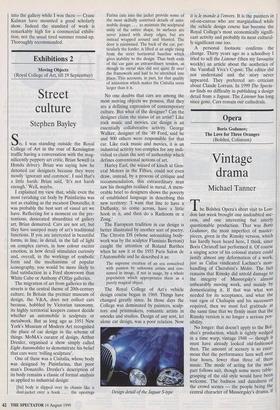Exhibitions 1
Collage: The Pasted-Paper Revolution (Crane Kalman Gallery, 178 Brompton Road, SW3, till 7 September)
Cut and paste
Andrew Lambirth Collage' has other meanings than sticking bits of paper together. Certainly in the 19th century it meant living in sin (what might be termed a more figurative way of sticking together), and Daudet uses it in his novel Sappho (1884) to refer to the situa- tion of a young man not merely taking a mistress, but setting up house with her. Collage as an art form, however, is com- fortably thought to be the invention of the Cubists, because in 1912 Braque first stuck a piece of imitation wood-grain paper onto a drawing. (Being the son of a painter and decorator, he knew about these things.) Picasso followed suit, and modern collage — or at least collage as fine art — was born.
Actually, there were substantial prece- dents. To take but two examples, the Japanese had been making text collages embellished with foil since the 12th centu- ry, while for many individuals in the West cutting paper was a favoured hobby. Hans Christian Andersen (1805-1875), for instance, was a dab hand at cut-outs. Col- lage, or at least an unsophisticated version of it, was a parlour game and a valued dis- traction for sick children. (But then so are painting and drawing. For many people, this is art's only use.) Because of its general accessibility, collage is thus considered to be easy: if you can't draw, you can at least knock out a collage. It's rather like water- colour. Nearly anyone can make a fist of doing it, but it's very difficult to do well.
Such ruminations are occasioned by an impressive exhibition of modern collages currently gracing Knightsbridge at the Crane Kalman Gallery. Some are for sale, but many are borrowed from the consider- able range of private collections prepared to lend to this highly reputable and old- established gallery. There are no collages by Braque or Gris, and only one small Picasso (it might have been better to exclude it, for it only underlines the short- fall), and nothing by Matisse, but these omissions are more than compensated for by a magnificent series by the little-known Russian abstractionist Olga Rozanova (1886-1918). This set of 12 paper and fab- ric collages made in 1916 for an artist's book to accompany poems by Kruchenykh, have a freshness of invention and a com- pelling grandeur which by themselves make this exhibition worth a visit. But there is much else to enjoy besides.
Another abstract image — collage over linocut — by Lazio Moholy-Nagy has a spare but satisfying geometry. A curved slice of card sits on top of the printed shapes, floating as it were on the surface. At once it emphasises the flatness of the composition while at the same time creat- ing depth. This is one of the things collage can do effortlessly, and is why it was so val- ued by the Cubists. Other artists use it in different ways. Romare Bearden uses col- lage for the snazzy juxtaposition of styles — placing the naturalistic against the schematic or cartoony. Robert Rauschen- berg makes a photographic transfer of col- laged imagery. George Grosz takes a collage a step further into photomontage, achieving a horrific hybrid photo form.
Julian Trevelyan creates a dream land- scape with hills of newsprint, cunningly overpainted. Others move more firmly into 3D. Peter Blake, master collagist who is curating his own survey exhibition of col- lage at the Tate Liverpool in spring 2000, has used many types of found wood along with corrugated card, a headless stone stat- uette and a ruler, in his striking `Hommage to Kurt Schwitters' (1987). Tatlin does odd things with metal and leatherette, and Cor- nell makes collage into a box. Among the other exhibits are fine collages by Schwit- ters himself, Ben Nicholson, Dubuffet and Hannah Hoch. I also liked Motherwell's Gauloise packet.
The exhibition is accompanied by a cata- logue (£15) containing essays by Clement Greenberg (from 1958) and Diane Wald- man. Greenberg maintained that after Cubism collage was chiefly valued for its shock value, either for art stunts or decora- tion. In the light of this exhibition, that judgment seems somewhat harsh. As Peter Blake remarked — he happened to come Bugatti 5 litres', 1922, by Ben Nicholson into the gallery while I was there — Crane Kalman have mounted a good scholarly show. Indeed the standard of work is remarkably high for a commercial exhibi- tion, not the usual tired summer round-up. Thoroughly recommended.



























































 Previous page
Previous page